Abita Mystery House
It costs three dollars to see the permanent and ever-growing collection of the Abita Mystery House if you are over the age of three. Or anyway it costs three dollars if you are over the age of three and not wearing a Batman t-shirt.
At least that was the criteria on a recent visit, when a group of three adults and four children, all well over the age of three—with the exception of a baby who was allegedly “on her way” with another parent—entered the Abita Mystery House through the museum’s gift shop.
- John Preble
- John Preble
- John Preble
John Preble, the owner and founder of the museum and the artist behind its winding menageries, looked up from his perch and welcomed the guests, counting all seven. “It’s three dollars apiece,” he said, “except for Batman. He gets in free.”
The introduction to what lay beyond the gift shop’s door was short and sweet. “There’s nothing private, nothing’s gonna jump out at you,” Preble said, a well-rehearsed line that you could tell he wished he didn’t have to say. “We have no live snakes on exhibit.”
“And if we break it, we’re buying it?” one woman asked with a thick Southeast Louisiana accent.
“No,” Preble said. “You can have it.”
The group passed by, agreeing to pay the cost of admission after the self-guided tour, and Preble turned back toward me. “This is one of the greatest jobs in the world,” he said. “I never pictured myself behind the counter of a museum gift shop, but after fifteen years, I’ve met all sorts of people.”
Before I left New Orleans to make the hour-long drive to Abita Springs, I called Preble to let him know I was running a little late. “What are you late for?” he asked. “Who are you?”
Upon arrival, after taking myself on a tour of the miniature Second Line scene, the two-person organ (one cranks, one plays) and a cave carved out for a miniature being, curiously titled “Ned’s Claim,” among other treasures, I sat down for an interview with Preble, only to learn that he would also be interviewing me.
- Second Line
- Organ
- Ned’s Claim
“I’m going to ask you as many questions as you ask me,” he warned.
Abita Springs is dangerous for the unanchored, dreamy, Flannery O’Connor−admiring woman I am, and if you have a proclivity for randomly moving to small, charming Southern towns, I’d warn against visiting. The town exists in that perfect, liminal space between old and new: a town square out of some broadside you might pick up on Magazine Street in New Orleans, but with enough fresh paint and advertisements for a farmer’s market to remind you what century you’re living in.
The museum, which is difficult to describe without relying on heavily used guidebook lures like “Kitschy!” and “Off-the-beaten-path!” achieves this same meeting of antiquity and modernization. Though, in this case, antiquity comes in the form of a 1920s-era coin-operated monkey in a glass box, and modernization comes in the form of well-dressed tourists from Boston.
- Inside corridors of the Abita Mystery House
- Outside corridors of the Abita Mystery House
- Wildlife
Wandering through the covered walkway, past hundreds of bottle caps, two alligator snapping turtles, and a sign that reads “Over 15,000 pieces of tiles mirrors + plates” (I didn’t count, but I have no reason to doubt it), the most arresting view is how, in attempting to breathe new life into a hodgepodge of old collectibles, Louisiana wildlife has managed to find a place to breathe. Coral flowers shaped like trumpets hang just above your forehead, and the possibility of a snake slowly slithering over your sneaker seem an almost predictable possibility.
Preble covered an outer wall in a pastel mosaic, a project that must have taken more patience and time than he’d readily admit (“Most of the stuff back there took me a month at night,” he says, later, with mock humility), and spring green vines have begun to cover the mosaic; a project that, knowing the Louisiana tropics, must have taken a single night.
Preble opened the museum in 2000 after a trip to Albuquerque in 1999 changed his life. He’s had at least twenty jobs, he said, and his work for a natural birth control company, which aimed to help women predict fertility based on the consistency of their vaginal mucous, had slowed. Preble and his wife and two boys, aged five and ten, were broke, but not broke enough to miss out on a Southwest Airlines deal for $100 tickets to any location within the United States.
Preble and his wife had friends in New Mexico, and while the family was taking in the sights of Taos and Santa Fe, they stumbled into Tinkertown.
Tinkertown is a museum of collectibles and miniature towns with walls built with old glass bottles and with an allure that depends on curiosity and wonder, run by the painter and craftsman Ross Ward.
“He had all the same crap I had!” said Preble, who began collecting all sorts of things as a child. “My father collected stamps. My parents didn’t discourage me from collecting. My parents were very, very generous. And I was a good child. I don’t do drugs, I don’t smoke weed, I don’t drink. I have sexual perversions, but in the South, they’re not considered perversions.”
Preble couldn’t believe his eyes. As an art student, he said, he was never able to do the kind of work that interested him without finding himself amongst a pretentious and stuffy crowd. He did not like the kind of people who bought his work at galleries in the French Quarter, and he did not like the kind of people who critiqued and complimented him.
“I just was shocked,” he says of his first visit to Tinkertown. “Because I used to do stuff and build stuff with bottles in walls, and I used to be around people who built stuff. Weird stuff. Weird houses to live in, trucks out in the yard to live in, stuff like that. And now here you are, and you’re charging admission!”
Preble asked Ward if others had tried to imitate the museum in other parts of the country. Ward told Preble that people had tried without much success, but Preble knew he had something that others who had ventured into the business did not: he had Southeast Louisiana.
“His was Western-themed,” Preble said, “whereas this is Louisiana.”
In the fifteen years he’s been operating, Preble has never kept track of how many visitors he has, and he seemed equally unclear as to how much money he has made. He’s never advertised (“Why would we, when we have people like you writing about it?” he said with a smile.) Besides the three-dollar admission fee, he operates the gift shop, which is full of little broadsides he’s painted and rubber lizards and magnets touting the museum’s many wonders. Out back Preble has a couple of penny-flattening machines, which cost a quarter, in addition to some other vending-machine style antiques.
A boy of about twelve comes into the gift shop mid-tour to ask for four quarters. It’s a common request, “and well it should be,” said Preble. “There’s good stuff back there!”
The Abita Springs Mystery House is never exactly the same on any given two days. You might have to squint to find the addition, but Preble insists on doing artistic work every day, even if that means no more than nailing a bottle cap to a wall.
“I tell everybody, that’s the most important thing,” he said. “After fifteen years, it really adds up. People come in and search for what’s new. Some people have been here a dozen times.”
I started to ask another question, but Preble turned the point around on me. “In fact,” he said, “you should be writing every day. Nothing is more important than writing. And if you want to be a writer, you need to do it every day.”
- Handmade dinosaur
- Bicycle
- Airstream trailer−turned−spaceship
It can take you as long to walk through the museum as you want it to, and if you go too fast, you might mistake Preble’s collection for nothing more than a cradle for his nostalgia. And while the old signs taken from airports and junkyards might get tiresome, there’s a sincerity and imagination in the art of collecting that comes through at every turn. An airstream trailer-turned-spaceship stands adjacent to a massive, handmade dinosaur, inexplicably smothered by a rain shed roof.
Preble’s wife, Anne, died seven years ago. He lives in a “too-big” house in Abita Springs, alone, and takes enormous pleasure from handing out free sodas to FedEx and UPS drivers (“I like my packages to be hand-delivered”) and encouraging children to count out their own change when paying admission. More than anything, though, I think he aims to teach, whether he would readily admit it or not. Telling his own story, he frequently interrupts himself with a lesson (“Life should be fun. Why shouldn’t all you do be fun?”).
To close, I asked him what he hopes visitors learn from the museum, what he hopes they come away with after leaving the Abita Mystery House behind them. He gave me a look, then smiled and shook his head. “Are you serious?” he asked.
I laughed nervously and defensively.
“Come on,” he said. “You know that’s not a good question.”
*All photos by Jeanie Riess


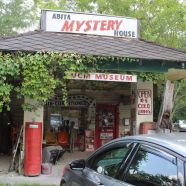






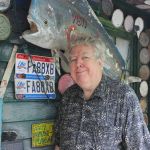


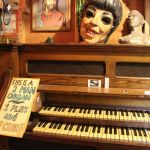
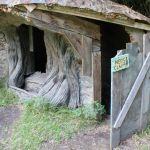
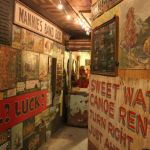
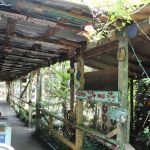

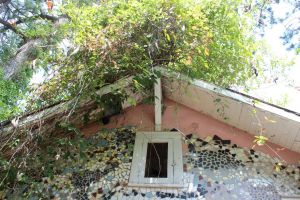
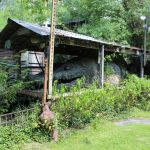
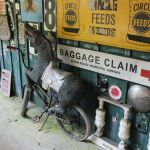
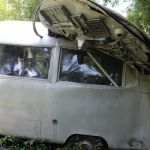
This is a delight. From the pen of someone who has written about New Orleans and the Miss. Delta too! Rich experience — good luck with future writing adventures.
I’m reading this for the first time. Well done.